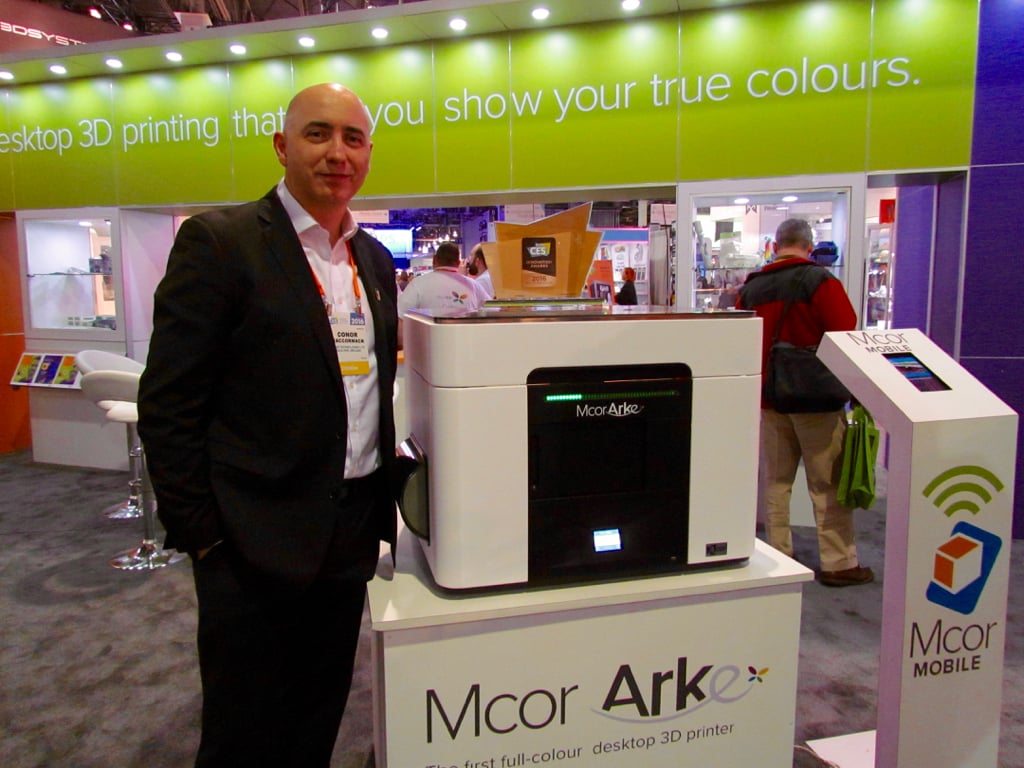
MCOR Technologies announced a very attractive full-color 3D printer based on their paper technology last January, but a recent announcement describes some key changes.
The company has long marketed paper-based 3D printers, which use a very different approach to other 3D printers: paper layers are glued together and cut along the object’s perimeter to create a fully 3D object. It’s a fast process that uses a very low-cost material: paper!
In subsequent years the company began experimenting with color prints by simply pre-printing appropriate textures on the edges of the paper layers. The concept worked very well and produced the second known full color process in the industry, and one that was far less expensive than the alternative.
The color printing concept was further refined with the introduction of the Arke in January, which deeply integrated the color function directly into the printer, where previously it had been a separate component. This presented the opportunity for a finely tuned, powerful color 3D printer – at low cost.
But in a recent post on the company’s blog, MCOR announced some changes to the machine. Four technical changes and one financial change were announced.
They’ve increased the number of possible colors producible by the Arke to “2 MILLION”. That’s a big number that’s beginning to approach the theoretical limit of human color perception (which I am told is around 10 million unique colors). They’ve done so by combining a couple of changes:
- New software compression algorithms, which presumably are less lossy;
- A new paper formulation, which must be able to show a wider color spectrum;
- A new ink formulation, which obviously would assist this development.
They’ve also included a new binder to glue paper sheets together, which supposedly doubles the stiffness of printed parts. That change should decrease criticisms of “weak paper prints” we’ve heard in the past.
The ARKE machinery itself has been made much more robust with a change to higher capacity slide rails, a more precise heating mechanism and a reinforced chassis. Why do all this? Because the process involves pressing the layers together during gluing, and it seems they’ve decided to increase the press force substantially. I presume this is to strengthen the prints.
MCOR has also introduced a new software management system, strangely called, “Orange Peel”. They explain:
With the introduction of our new ‘Orange Peel’ software users will enjoy professional features that will assist with file preparation including splitting and joining files, colour and texturing and file modification including smoothing, solidifying and extruding surfaces.
That’s all good stuff. But there’s one other change that some clients may not like: the price has increased substantially.
In January, the machine was announced with a price of USD$8,995. Now, just before the machine is released, the price has been upwardly adjusted to €17,995 (USD$17,995). That’s almost twice the original price!
However, there’s reasons for this, beyond the improvements mentioned above.
Their competition in the full-color 3D print market, 3D Systems, still has not released their elusive CubeJet low-cost color 3D printer, which has been mysteriously shown EACH YEAR at CES SINCE 2014!
Without the CubeJet, users seeking full color 3D print solutions must consider 3D Systems’ more expensive color solutions, or move to Stratasys’ new J750, both of which are multiple times more expensive than the new ARKE price level.
I think in this case, lack of competition has resulted in a higher price.
Via MCOR

